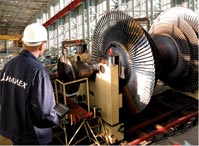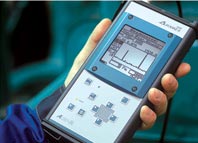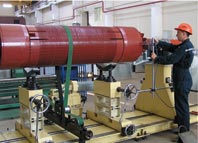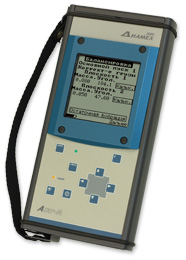RotorBalancer - Technical Data
Measurement tasks
- Field balancing of rotors in one and two planes
- Measurement of overall vibrations for evaluation of the machine condition
- Frequency analysis for identification of machine faults and damages
- Start-up and run-down analysis of the first harmonic for the detection of machine resonance's
- Display of the overall vibrations as well as of the first harmonic vs. time
- Visualization of vibration time-signature
Measurement channels
- 2 channels for vibration
- 1channel for rotor speed and reference signal
Measurement inputs
- 2 inputs for acceleration sensors
- 1 input for laser optical reference sensor
Measurement values
- Vibration displacement in Ám and mils
- Vibration velocity in mm/s and inch/s
- Vibration acceleration in m/s2 and g
Signal detection types
- RMS value
- Peak-to-peak value
- Peak value
Field balancing
- Easy-to-understand operator dialog, integrated balancing calculator, polar presentation of unbalance and test run vectors and printed balancing reports via PC/Laptop.
- Balancing rotor speed: 120 to 20,000 rpm.
- Number of balancing planes: 1 or 2.
- Number of measuring points: up to 4 (enables optimized balancing procedures).
- Archiving of rotor influence coefficients to enable simplified balancing procedures in repeat situations.
Measurement of overall vibrations
- Broadband vibration measurement in pre-selectable frequency ranges
- High-pass steps 2/5/10/20/50/ 100/200/500/1,000 Hz
- Low-pass steps 100/200/500/ 1,000/2,000/5,000/10,000 Hz
- Number of averages: 0 up to 100
Frequency analysis
- Narrow band measurement for separation of the machine vibration into their harmonic portions.
- FFT analysis, either without external trigger (free run) or with rotor-synchronous data acquisition.
- High-pass steps: 5/10/20/50/100/200/500/1,000 Hz
- Low-pass steps: 100/200/500/1,000/2,000/5,000/10,000 Hz
- 2./5./10./20. harmonic with rotor-synchronous data acquisition.
- Resolution: 100/200/400/800 lines
- Number of averages: 0 to 100
- Windowing functions: Hanging and Uniform (Rectangular)
- FFT analysis in the frequency range 5 to 10,000 Hz by means of 33 frequency bands with a constant relative bandwidth (26%) and with logarithmic graphical display.
Start-up and run-down analysis
- Measurement, archiving and graphical display of the amplitude and the phase angle of the first harmonic in pre-selec-table rotor speed ranges.
- Max. rotor speed range: 120 to 9,000 rpm
- Resolution: 100 lines
Overall vibration and first harmonic vs. time
- Measurement, archiving and graphical display of the characteristic values for overall vibration as well as for amplitude and phase angle of the first harmonic in pre-selectable time ranges.
- Number of averages: 0 to 100.
- Number of depictable data sets: 5 to 100
Vibration time-signature
- Visualization of the vibration waveform.
- Frequency range: 2 to 10,000 Hz, with rotor-synchronous data acquisition up to the 20. harmonic. Sampling period: 2/5/10/20/ 50/100/200/500/ 1,000/2,000/5,000 ms
- Number of samples: 256/512/ 1,024/2,048
- Number of averages with rotor-synchronous data acquisition: 0 to 100
- Number of depictable data sets: 5 to 100
- Resolution: 256/512/1,024/2,048 points
General features
- Display: Monochrome LCD with 128 x 128 Pixel and backlit.
- A/D-converter: 14 Bit resolutions
- Storage capacity of the internal EEPROM memory: 2 MB (for firmware and measurement data)
- Accuracy of the indicator unit: 5%
- USB interface for data upload to PC/Laptop
Power supply
- With built-in rechargeable battery, storage capacity: 1,6 Ah.
- Typical battery operation period: not less than 6 h.
- Battery charge time: not more than 3 h.
- Power and charger unit for 240 V, 50/60 Hz.
Mechanical construction of the indicator unit
- Aluminium housing of rugged and shockproof design.
- Protection class IP 54
- Operating temperature range: -10░ to +50░ C
- Relative air humidity: 0 to 95%, not condensing.
- Dimensions: 220 x 110 x 38 mm
- Weight: 900 g
Soft case
- Dimensions: approx. 300 x 250 x 200 mm
- Weight incl. standard extent of delivery: approx. 3,5 kg.
DIAMECH 2000: Vibration Diagnostic and Balancing Machines
phone: +7 (495) 223-04-20
fax: +7 (495) 223-04-90
e-mail: contact@diamech.ru
|









Since 1989
Vibration Diagnostic and Balancing Machines
